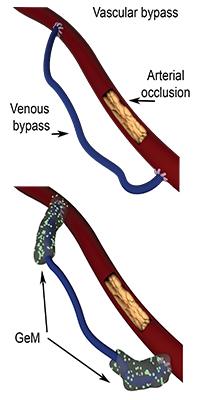The vascular bypass revolution

Credit: © UNIGE
Coronary or peripheral bypasses are the most frequently performed vascular operations. Although one million patients per year and around the world, undergo this intervention, its failure rate reaches 50%, because of poor vessel healing, leading to vessel graft occlusion.
To improve the outcome of bypasses, researchers from the University of Geneva (UNIGE) work together with medical doctors from the Lausanne University Hospital (CHUV). They developed a gel containing microparticles -'GeM', enabling the controlled release of a drug inhibiting cellular over-proliferation.
Administered locally, directly on the bypass graft during surgery, this preventive treatment will reduce the risk of obstruction reoccurrence. This research can be read in The Journal of Controlled Release.
The vascular bypass allows a blocked artery to be bypassed by implanting a vessel removed from the patient, and this is done in order to create a deviation in circulation. However, in 50% of cases, excessive vascular cell proliferation, called hyperplasia, occurs around the suturing site of the transplanted vessel.
Hyperplasia then leads to a decrease in blood flow within five years following the operation, requiring a new surgery. Today, doctors prescribe atorvastatin (ATV) orally against hyperplasia. However, this route of administration is not adapted to this pathology.
This is why Doctor François Saucy's team from CHUV joined forces with Florence Delie and Olivier Jordan, researchers at the Department of Pharmaceutical Sciences at UNIGE Faculty of Science. The goal: to find a way for local administration of ATV, that will remain available over a long time period, in order to overcome the disadvantages of high dosage taken orally.
'We immediately thought of a gel mixed with ATV, being directly applied on the vessel during surgery. Being viscous, it remains in place and enables local release, explains Florence Delie. 'But, we had an important challenge- doctors recommended the presence of the drug over a period of four weeks to avoid hyperplasia development, while the gel is only effective for three days'.
Researchers from UNIGE have consequently added polymer microparticles containing ATV to the original formulation. These microparticles carry the encapsulated drug and gradually dissolve into the gel, therefore releasing ATV over one month.
The right dose in the right place
'It is about a controlled release system: the right dose at the right place, with the correct release profile, emphasises Olivier Jordan. 'We discovered that this formulation only works using the combination of, on one side, quickly released ATV mixed into the gel and on the other side, the microparticles, which act over the long term. There lies our innovation', adds Ioanna Mylonaki, researcher at UNIGE. 'Its use on patients is contemplated in five to ten years. Its efficacy would revolutionize the success rate of vascular bypasses.'
Media Contact
All latest news from the category: Medical Engineering
The development of medical equipment, products and technical procedures is characterized by high research and development costs in a variety of fields related to the study of human medicine.
innovations-report provides informative and stimulating reports and articles on topics ranging from imaging processes, cell and tissue techniques, optical techniques, implants, orthopedic aids, clinical and medical office equipment, dialysis systems and x-ray/radiation monitoring devices to endoscopy, ultrasound, surgical techniques, and dental materials.
Newest articles

First-of-its-kind study uses remote sensing to monitor plastic debris in rivers and lakes
Remote sensing creates a cost-effective solution to monitoring plastic pollution. A first-of-its-kind study from researchers at the University of Minnesota Twin Cities shows how remote sensing can help monitor and…

Laser-based artificial neuron mimics nerve cell functions at lightning speed
With a processing speed a billion times faster than nature, chip-based laser neuron could help advance AI tasks such as pattern recognition and sequence prediction. Researchers have developed a laser-based…

Optimising the processing of plastic waste
Just one look in the yellow bin reveals a colourful jumble of different types of plastic. However, the purer and more uniform plastic waste is, the easier it is to…



